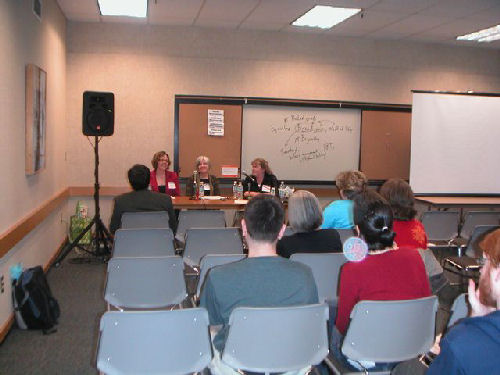BETSY ROLLAND
|
iEdge 2007: Organizing a Conference On March 28, 2007, the first annual iEdge conference, iEdge 2007: So What? Research into Practice, was held in the HUB on the Seattle campus. The conference consisted of a keynote speaker, three tracks each with three sessions and a panel, followed by a reception and poster session. This conference was organized by Kathleen Walsh, my ASIS&T co-Chair and iEdge co-Founder, and I, with assistance from over 25 volunteers. The idea for the conference was to provide a forum where students, staff, faculty and alumni could learn more about the research currently happening at the iSchool, as well as get a better sense of how the research we do in our classes could be leveraged in our professional lives. Our first step was to apply for funding from the Learning for Leadership Council. We met with Bob Mason to discuss our ideas and received some excellent guidance on what might make a successful conference. Our application for funding was approved by the LLC, and the real work began! Bob suggested that we begin our conference planning by identifiying not only the mission of our conference but the mission of each of the three tracks. We devised the following: iEdge 2007:The mission of iEdge2007 is to help students and information professionals understand how information science research can be integrated into and leveraged in professional life. We have three tracks with the following themes:
Once we have defined our goals and objectives, we split up the tracks and sessions and begin contacting presenters we felt would not only meet those objectives but be interesting to our audience. Virtually all of the presenters we contacted were happy to participate. Getting people to participate in the poster session was more difficult. Most Master's-level students have never been to an academic conference and had no idea what an academic poster looks like. When our deadline came and went with only one poster application, we began contacting students we knew were doing interesting work and trying to persuade them to create and show a poster on that work. We eventually had 14 poster presenters agree to participate, including some alumni, which was an excellent showing. We hope that next year's conference will have even more posters. The actual conference itself was a complete success, and the day went off without a hitch. The only remotely disappointing aspect was that our attendance numbers were lower than we had hoped. Our original target was 250 attendees, including volunteers and presenters. We ended up with about 150 registrants, plus volunteers and presenters. Our actual attendance was about 100 people who attended various sessions throughout the day. While this is significantly less than we had anticipated, it was still quite good for a first event. In addition to organizing the conference, I was also a presenter. I asked Trent Hill to present a workshop on building a thesaurus, and he, in turn, asked my LIS 537 group to present with him. Our session was well-subscribed and well-attended. Trent gave an overview of the theory, then our group talked about our experience in creating our thesaurus. Though no one in our group had never presented at a conference before, we did very well! We timed the conference to coincide with the MLIS distance residency, because we felt strongly about including the distance students. We had one distance student as a presenter, one distance student present a poster, and a couple of distance students as volunteers. We also had volunteers from the MSIM and Informatics program and a few presenters from the PhD program, as well as the Technical Communication, BHI and Communications departments. It was important to us that this be an opportunity for all of us to make new contacts throughout the UW community. We learned many lessons while planning this conference, all of which we will document and pass on to next year's ASIS&T officers. My hope is that this will become an annual event and grow into something appreciated and anticipated by the iSchool community. Those in attendance at this year's conference expressed similar hopes for the conference. This was a significant leadership experience for me, as it involved identifying a need, then figuring out a way to meet it through creating a vision of an event, organizing many volunteers and ensuring that the event went well. Perhaps more importantly, it gave me the opportunity to create a means for other students to gain leadership experience. We had extraordinary volunteers to whom we were able to delegate significant pieces of the conference. Next year, some of those volunteers will be leading ASIS&T and organizing this conference.
|


